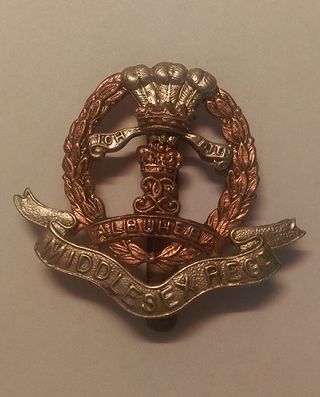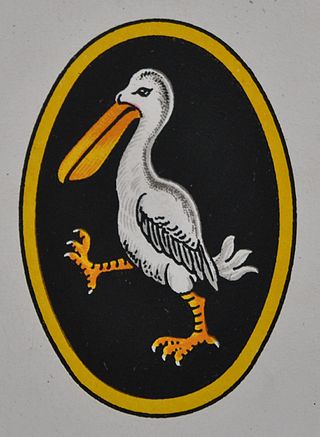
The 132nd Infantry Brigade was an infantry brigade of the British Army that remained in British India during the First World War. During the Second World War, it served with the 44th Infantry Division in Belgium and France, later being evacuated at Dunkirk and seeing service again in North Africa at El Alamein before being disbanded in January 1943.

The Middlesex Regiment (Duke of Cambridge's Own) was a line infantry regiment of the British Army in existence from 1881 until 1966. The regiment was formed, as the Duke of Cambridge's Own (Middlesex Regiment), in 1881 as part of the Childers Reforms when the 57th (West Middlesex) and 77th (East Middlesex) Regiments of Foot were amalgamated with the county's militia and rifle volunteer units.

The 62nd Division was an infantry division of the British Army that saw active service on the Western Front during the First World War.
The 156th Brigade was an infantry brigade formation of the British Army. The brigade saw active service in both the First and the Second World Wars with the 52nd (Lowland) Infantry Division.
The 157th Brigade was an infantry brigade of the British Army. The brigade fought in both the First and the Second World Wars, assigned to 52nd (Lowland) Infantry Division.
The 2nd Surrey Brigade was a 2nd Line Territorial Force Brigade of the British Army in World War I. The brigade was formed as a duplicate of the Surrey Brigade in October 1914 as part of the 2nd Home Counties Division. As the name suggests, the brigade recruited in Surrey. In August 1915, in common with all Territorial Force brigades, it was numbered as 200th Brigade. Between September 1917 and the end of the year, the brigade was extensively reorganized and lost its territorial identity; henceforth it was known as 200th Brigade. It was demobilized in February 1918.
The 2nd Kent Brigade was a 2nd Line Territorial Force Brigade of the British Army in World War I. The brigade was formed as a duplicate of the Kent Brigade in October 1914 as part of the 2nd Home Counties Division. As the name suggests, the brigade recruited in Kent. In August 1915, in common with all Territorial Force brigades, it was numbered as 202nd Brigade. Between September 1917 and the end of the year, the brigade was extensively reorganized and lost its territorial identity; henceforth it was known as 202nd Brigade.
The 214th Brigade was an infantry formation of the British Army during World War I. It was raised as a second line brigade of the Territorial Force and initially assigned to the 71st Division for coast defence. Later it was reorganised as an all-arms brigade group for service in North Russia, but this was cancelled and it was reassigned to the 67th Division, a training and home defence formation, until the end of the war.
The 206th Brigade was a formation of the British Army during World War I. It was raised as a 2nd-Line duplicate of the Essex Brigade of the Territorial Force and formed part of the 69th Division. It served as a training formation in the United Kingdom without going overseas.
The 213th Brigade was a Home Defence and training formation of the British Army during both the First and Second World Wars.
The 134th Infantry Brigade was an infantry brigade of the Territorial Force, part of the British Army. It was formed in the First World War as a duplicate of the Hampshire Brigade and was originally formed as the 2nd/1st Hampshire Brigade in 1914–1915 before later being renamed as the 134th Brigade. It was sent overseas to India in December 1914 to relieve Regular Army units for service in France. The brigade remained there for the rest of the war, supplying drafts of replacements to the British units fighting in the Middle East and later complete battalions. By September 1917 the last of its battalions had departed.
The 136th Infantry Brigade was an infantry brigade of the Territorial Force, part of the British Army. It was formed in the First World War as a duplicate of the Devon and Cornwall Brigade and was originally formed as the 2nd/1st Devon and Cornwall Brigade in 1914–1915 before later being renamed as the 136th Brigade. It was sent overseas to India in December 1914 to relieve Regular Army units for service in France. The brigade remained there for the rest of the war, supplying drafts of replacements to the British units fighting in the Middle East and later complete battalions.
221st Mixed Brigade was a Scottish Home Service formation of the British Army that served under various titles throughout World War I.
The 224th Brigade was a Home Defence formation of the British Army in World War I and World War II. It existed under several variations of the 224th Brigade title.
The 225th Brigade was a Home Defence formation of the British Army in the First and the Second World Wars. It existed under several variations of the 225th Brigade title.
71st Division was a short-lived infantry division of the British Army during the First World War. It served in the Home Defence forces and never went overseas.
72nd Division was a short-lived infantry division of the British Army during World War I. It served in the Home Defence forces and never went overseas.
73rd Division was a short-lived infantry division of the British Army during World War I. It served in Home Forces and never went overseas.
The 2nd Home Counties Division was a 2nd Line Territorial Force division of the British Army in World War I. The division was formed as a duplicate of the 44th Division in November 1914. As the name suggests, the division recruited in the Home Counties, particularly Kent, Middlesex, Surrey and Sussex. In August 1915, in common with all Territorial Force divisions, it was numbered as 67th Division. Between September 1917 and the end of the year, the division was extensively reorganized and lost its territorial identity; henceforth it was known as 67th Division.


